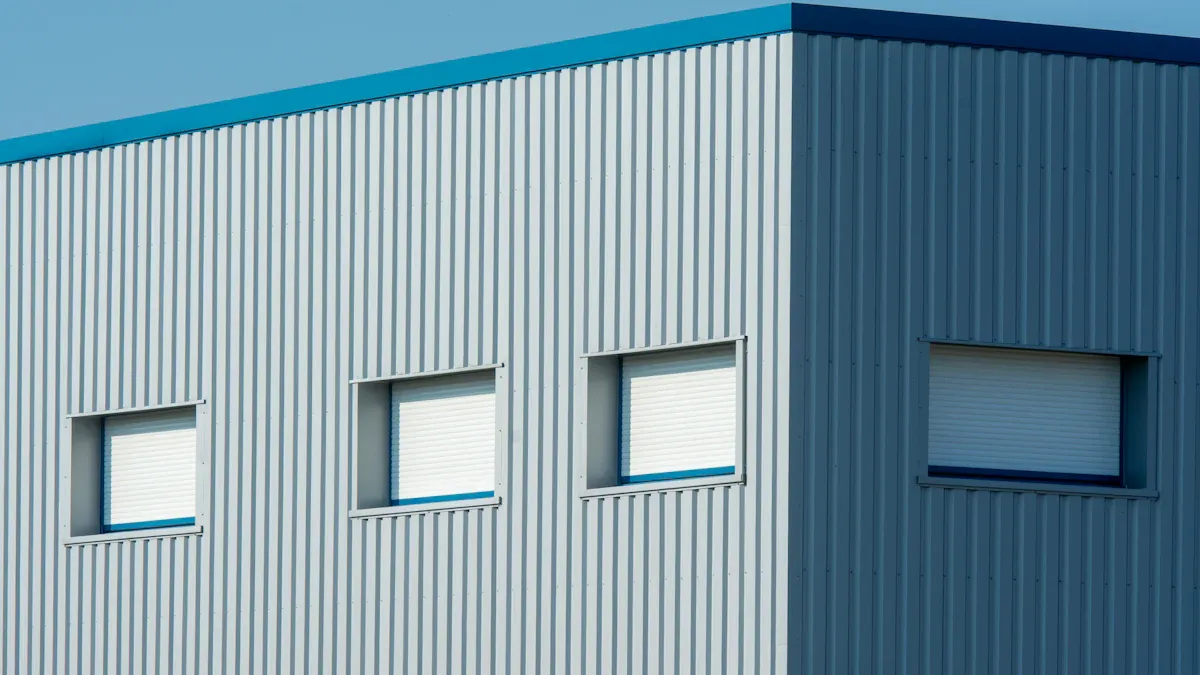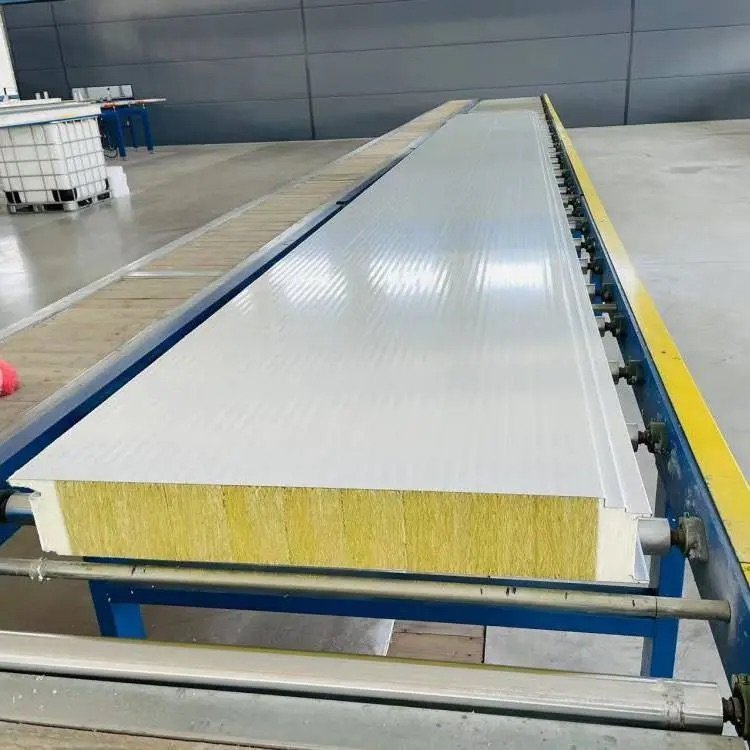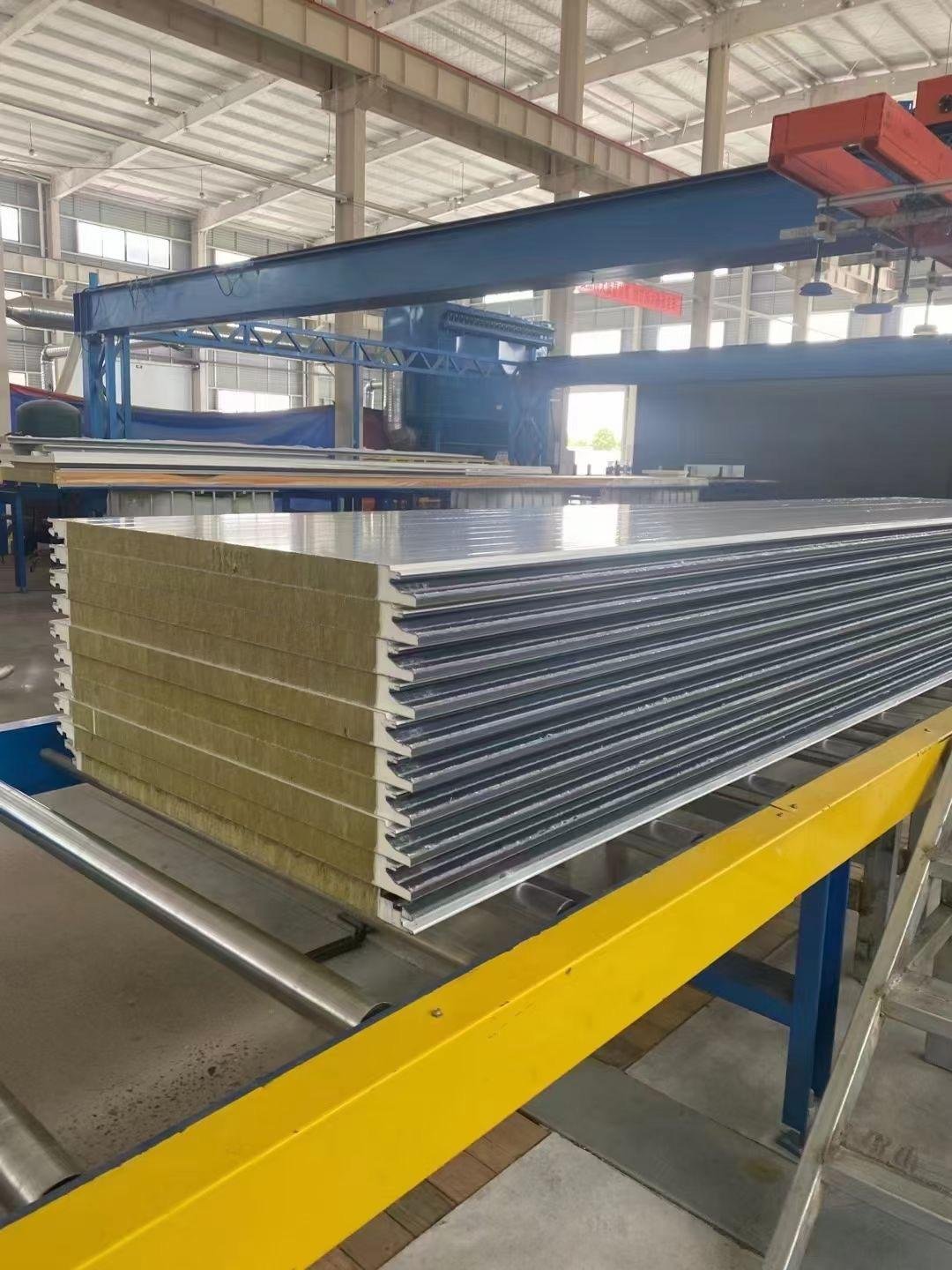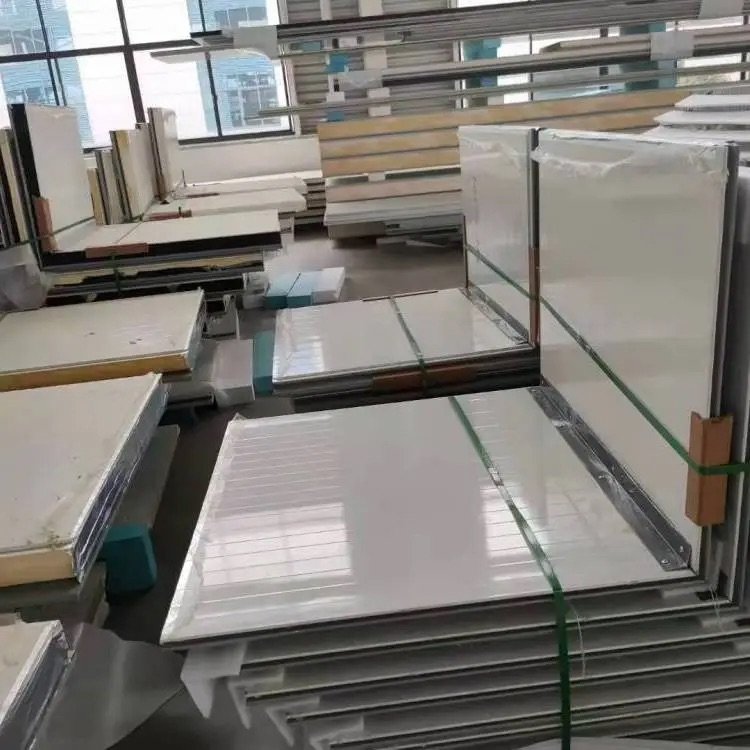
A PU sandwich panel is a composite material designed with a rigid polyurethane foam core and protective outer layers. You’ll find these panels widely used in modern construction due to their exceptional insulation properties and structural strength. They help maintain energy efficiency by reducing the need for heating and cooling systems, making them a popular choice for walls, roofs, and facades. The global market for these sandwich panels is growing rapidly, valued at $9.5 billion in 2023 and projected to reach $16.8 billion by 2032. This growth reflects their role in creating energy-efficient buildings and meeting environmental standards.
Key Takeaways
PU sandwich panels keep heat in or out, saving energy costs.
They are light and easy to install, saving time and money.
These panels resist fire well, staying safe and strong for use.
PU panels work for walls, roofs, and cold storage in buildings.
Using PU panels is eco-friendly since they can be recycled.
Key Features of PU Sandwich Panels

Excellent Thermal Insulation
PU sandwich panels are renowned for their excellent insulation capabilities. The rigid polyurethane foam core minimizes heat transfer, making these panels highly effective in maintaining indoor temperatures. This feature reduces the need for excessive heating or cooling, helping you save on energy costs.
These panels exhibit a low thermal conductivity range of 0.022-0.028 W/m·K, which ensures superior thermal insulation.
The foam core acts as a barrier against external temperature fluctuations, keeping your space comfortable in both hot and cold climates.
By choosing PU sandwich panels, you can achieve energy efficiency while ensuring a consistent indoor environment.
Lightweight and High Durability
The lightweight nature of sandwich panels simplifies installation. You can handle and position them easily without requiring heavy machinery. Despite their light weight, these panels offer remarkable durability, making them a long-lasting solution for various applications.
Lightweight construction reduces labor and equipment costs during installation.
High durability ensures minimal maintenance and extends the lifespan of the panels.
Their excellent insulation properties further enhance energy efficiency, making them suitable for diverse climates.
This combination of light weight and durability makes PU sandwich panels a practical and efficient choice for your building needs.
Fire Resistance and Safety
Safety is a critical factor in construction, and PU sandwich panels excel in fire resistance. Studies have shown that these panels maintain their structural integrity and insulation properties even under fire exposure. Tests conducted in accordance with EN 1364-1 standards highlight their ability to endure significant fire exposure while retaining thermal insulation and structural stability.
Research also emphasizes the importance of full-scale fire tests to accurately assess the performance of sandwich panels. These tests ensure that the panels meet stringent safety standards, providing you with peace of mind in both residential and commercial applications.
By incorporating PU sandwich panels, you can prioritize safety without compromising on insulation or durability.
Versatility in Applications
PU sandwich panels offer unmatched versatility, making them suitable for a wide range of applications. Their adaptability stems from their lightweight structure, excellent insulation, and durability. You can use these panels in various industries, including construction, refrigeration, and modular building systems.
Construction and Building: Sandwich panels are ideal for walls, facades, and roofing systems. Their thermal insulation properties help maintain comfortable indoor temperatures, reducing energy consumption.
Cold Storage and Refrigeration: These panels are widely used in cold storage facilities. The rigid polyurethane foam core ensures optimal temperature control, preserving perishable goods effectively.
Prefabricated Structures: Modular buildings benefit from the easy installation and portability of sandwich panels. Their lightweight nature simplifies transportation and assembly, saving time and resources.
The versatility of sandwich panels allows you to meet diverse construction needs while maintaining energy efficiency and structural integrity.
Cost-Effective Solution
PU sandwich panels provide a cost-effective solution for modern construction projects. Their affordability comes from reduced labor costs, faster installation, and long-term energy savings.
Quick Installation: Prefabricated sandwich panels speed up construction, cutting down project timelines significantly.
Labor Savings: Lightweight panels require fewer workers and less equipment during installation, lowering overall costs.
Energy Efficiency: The superior insulation properties of these panels reduce heating and cooling expenses, aligning with energy regulations.
Aspect | Evidence |
|---|---|
Construction Speed | Prefabricated techniques reduce construction time and ensure consistent quality. |
Labor Cost Reduction | Less manpower is required on-site, leading to lower overall construction costs. |
Energy Efficiency | Excellent thermal insulation properties contribute to energy savings and compliance with regulations. |
The growing demand for sustainable materials further enhances the appeal of PU sandwich panels. Governments worldwide are enforcing stricter energy regulations, and these panels help you meet those standards while reducing your carbon footprint. By choosing sandwich panels, you invest in a durable, efficient, and eco-friendly building solution.
How Polyurethane Sandwich Panels Work
Structure of Sandwich Panels
Core Material: Rigid Polyurethane Foam
The core of polyurethane sandwich panels consists of rigid polyurethane foam. This material plays a vital role in the panel’s performance. It provides excellent energy absorption, which helps reduce damage during impacts. The foam’s crushable nature dissipates energy effectively, protecting the outer layers. Unlike panels with no filling or resin-filled cores, polyurethane foam-filled panels show significantly less damage. For instance:
Foam-filled panels exhibit a damaged area of 995.5 mm², compared to 201.34 mm² in resin-filled panels.
The foam enhances stiffness and minimizes the risk of structural failure.
This core material ensures the durability and reliability of sandwich panels in various applications.
Outer Layers: Metal or Composite Sheets
The outer layers of sandwich panels are typically made of metal or composite sheets. These layers provide structural support and protect the foam core. They also enhance the panel’s resistance to environmental factors like moisture, UV rays, and mechanical stress. The combination of a rigid foam core and durable outer layers creates a robust structure that performs well under different conditions.
Insulation and Energy Efficiency
Polyurethane sandwich panels excel in insulation and energy efficiency. The foam core has one of the lowest thermal conductivity coefficients, which minimizes heat transfer. This feature ensures that your building maintains a stable indoor temperature, reducing the need for heating or cooling systems.
Metric | Description |
|---|---|
Thermal Conductivity Coefficient | PU sandwich panels have one of the lowest thermal conductivity coefficients, enhancing insulation. |
Absence of Thermal Bridges | The design ensures minimal thermal bridges due to the homogeneity of insulation throughout the panel. |
Reduced Insulation Thickness | The low thermal conductivity allows for thinner insulation, optimizing space and energy efficiency. |
By using these panels, you can achieve energy savings while maintaining a comfortable indoor environment.
Manufacturing Process Overview
The manufacturing process of sandwich panels involves precision and advanced technology. First, the rigid polyurethane foam is prepared and injected between the outer layers. The foam expands and bonds with the layers, creating a strong and uniform structure. After curing, the panels are cut to the desired size and shape. This process ensures consistent quality and performance, making polyurethane panels a reliable choice for construction and insulation needs.
Applications of PU Sandwich Panels

Construction and Building Industry
Walls and Facades
PU sandwich panels are widely used in walls and facades due to their excellent insulation and structural properties. These panels help maintain energy efficiency by reducing heat transfer, making them ideal for both residential and commercial buildings. Their lightweight nature simplifies installation, while their durability ensures long-term performance.
The demand for sandwich panels for facades continues to grow as sustainable building practices become a priority. These panels not only enhance thermal insulation but also improve the aesthetic appeal of buildings. For example:
Evidence Type | Description |
|---|---|
Thermal Insulation | PU sandwich panels reduce energy consumption for heating and cooling. |
Sustainable Practices | Their use aligns with the increasing focus on eco-friendly construction. |
By choosing sandwich panels for facades, you can achieve energy savings and meet modern design standards.
Roofing Systems
Sandwich panels for roofing are essential in construction projects where energy efficiency and durability are critical. These panels provide excellent thermal insulation, protecting buildings from extreme weather conditions. Their lightweight design reduces the load on structural frameworks, making them a cost-effective choice for roofs in warehouses, industrial facilities, and residential buildings.
Application Segment | Revenue Share (2023) | Projected CAGR (2024-2030) |
|---|---|---|
Roofs | N/A | 7.1% |
The versatility of polyurethane sandwich panels makes them suitable for various roofing applications, ensuring long-lasting performance and reduced maintenance costs.
Cold Storage and Refrigeration
Cold storage facilities rely heavily on PU sandwich panels for maintaining precise temperature control. These panels offer superior thermal insulation, which is crucial for preserving perishable goods like frozen food, meat, and dairy products. Their ability to resist vapor diffusion and maintain consistent temperatures makes them indispensable in refrigeration systems.
Feature | Details |
|---|---|
Panel Thickness | 100 mm |
Effective Widths | 930, 1000, 1120 mm |
Thermal Insulation Performance | Excellent under high and low temperatures |
Fire Resistance | B level fire resistance |
By using these panels, you can ensure energy efficiency and product safety in cold storage environments.
Industrial and Commercial Buildings
Polyurethane sandwich panels are a preferred choice for industrial and commercial buildings due to their self-supporting nature and ease of installation. These panels eliminate the need for additional supports, reducing overall construction costs. Their durability and recyclability also contribute to sustainable building practices.
PU sandwich panels are commonly used in offices, retail spaces, and hotels.
They provide excellent insulation, structural integrity, and aesthetic appeal.
The growing demand for energy-efficient materials drives their adoption in the commercial sector.
The quick installation process of these panels supports rapid construction methods, making them ideal for large-scale projects.
Prefabricated and Modular Structures
Prefabricated and modular structures rely heavily on PU sandwich panels due to their efficiency and adaptability. These panels simplify construction by enabling quick assembly and reducing on-site labor. Their lightweight design makes transportation and installation easier, which is essential for modular buildings.
One of the key advantages of PU sandwich panels in modular construction is their ability to maintain consistent quality. Prefabrication techniques ensure that each panel meets strict standards before reaching the construction site. This process minimizes errors and reduces material wastage, making your project more cost-effective.
Tip: Using PU sandwich panels can significantly cut down project timelines, allowing you to complete modular structures faster without compromising on quality.
The structural strength of these panels also enhances the durability of modular buildings. Their rigid polyurethane foam core provides excellent support, while the outer layers protect against environmental factors. This combination ensures that your structure remains strong and energy-efficient over time.
Metric | Evidence |
|---|---|
PU sandwich panels are noted for their energy efficiency, which is crucial in construction. | |
Quick Installation | The panels facilitate quick assembly, enhancing project timelines. |
Structural Strength | Their structural integrity supports the durability of modular constructions. |
Cost Savings | Reduced wastage and lower labor costs contribute to overall project savings. |
Prefabricated structures also benefit from the reduced need for extensive manpower. The ease of installation lowers labor costs and simplifies the construction process. Additionally, the panels’ excellent insulation properties help maintain comfortable indoor temperatures, reducing energy consumption in modular buildings.
Metric | Evidence |
|---|---|
Prefabrication Techniques | Many applications utilize prefabricated methods, ensuring consistent quality. |
Reduced Wastage | Prefabrication minimizes waste and rework on-site, leading to cost efficiency. |
Labor Cost Reduction | The ease of installation reduces the need for extensive manpower, lowering overall costs. |
By choosing PU sandwich panels for prefabricated and modular structures, you can achieve faster construction, lower costs, and long-lasting performance. These panels provide a reliable solution for creating energy-efficient and sustainable buildings.
Types of PU Sandwich Panels
Facade Panels
Facade panels made from PU sandwich materials are designed to enhance both the insulation and appearance of buildings. These panels provide excellent thermal insulation, reducing energy consumption and maintaining indoor comfort. Their low thermal conductivity minimizes heat transfer, making them ideal for energy-efficient construction.
Characteristic | PU Sandwich Panels | PIR Sandwich Panels |
|---|---|---|
Thermal Insulation | Low thermal conductivity, minimizes thermal bridges | Higher thermal stability, better fire resistance |
Mechanical Properties | Great rigidity, low weight for easy handling | Similar properties, but with enhanced fire safety |
Fire Resistance | Requires testing for compliance | Forms a protective layer during fire, less smoke |
Water Absorption | Virtually no absorption due to closed cell structure | Similar properties, waterproof |
Sustainability | Recyclable, generates little waste | Recyclable, sustainable manufacturing |
These panels also optimize usable space by requiring less thickness for insulation. Their lightweight design simplifies transportation and installation, saving you time and resources. Facade panels are a sustainable choice, as they are recyclable and generate minimal waste during production.
Roofing Panels
Roofing panels made from PU sandwich materials are essential for protecting buildings from extreme weather conditions. These panels combine durability with excellent insulation, ensuring your roof remains energy-efficient and long-lasting. The rigid foam core minimizes heat transfer, keeping indoor spaces comfortable in both hot and cold climates.
Roofing panels are available in various thickness categories, such as below 50mm, 51-100mm, and above 200mm, allowing you to choose the right option for your specific needs. Their lightweight nature reduces the load on structural frameworks, making them a cost-effective solution for warehouses, industrial facilities, and residential buildings.
Tip: Opt for roofing panels with a thickness that matches your climate requirements to maximize energy efficiency and durability.
Refrigeration Panels
Refrigeration panels are specifically designed for cold storage and refrigeration systems. These panels maintain precise temperature control, ensuring the preservation of perishable goods like food and pharmaceuticals. The rigid polyurethane foam core provides superior thermal insulation, while the outer layers resist moisture and vapor diffusion.
Refrigeration panels typically come in effective widths of 930mm, 1000mm, and 1120mm, with a standard thickness of 100mm. Their fire-resistant properties and excellent thermal performance make them a reliable choice for maintaining consistent temperatures in cold storage environments.
Using refrigeration panels helps you achieve energy efficiency while ensuring the safety and quality of stored products.
Customizable Panels for Specific Needs
PU sandwich panels offer a high degree of customization, allowing you to tailor them to meet specific project requirements. This flexibility makes them a versatile choice for diverse industries and applications. Whether you need panels for extreme weather conditions, unique architectural designs, or specialized industrial uses, you can modify their features to suit your needs.
You can customize the thickness of the panels to achieve the desired level of insulation. Thicker panels provide better thermal performance, which is essential for cold storage or refrigeration systems. For construction projects, you might prefer thinner panels to save space while maintaining energy efficiency.
The outer layers of the panels can also be adjusted. You can choose from materials like galvanized steel, aluminum, or composite sheets, depending on the environmental conditions and aesthetic preferences. For example, aluminum-coated panels resist corrosion, making them ideal for coastal areas. On the other hand, steel layers offer enhanced strength for industrial buildings.
Color and finish options add another layer of customization. You can select colors that match your building’s design or opt for finishes that improve durability, such as anti-scratch coatings. These choices allow you to balance functionality with visual appeal.
Specialized features, such as fire-resistant cores or soundproofing capabilities, can also be integrated. These modifications ensure that the panels meet safety standards and provide additional benefits for specific applications.
By customizing sandwich panels, you can create solutions that align perfectly with your project’s goals. This adaptability ensures that you get the most value out of your investment.
PU sandwich panels offer numerous advantages that make them a valuable choice for modern construction. Their energy efficiency helps you reduce heating and cooling costs, while their durability ensures long-term performance. These panels also adapt to various applications, from cold storage to modular buildings, making them highly versatile.
You’ll find PU sandwich panels widely used across industries due to their ability to meet energy regulations and sustainability goals. By choosing these panels, you invest in a solution that balances cost-effectiveness, functionality, and environmental responsibility.
FAQ
What makes PU sandwich panels energy-efficient?
The rigid polyurethane foam core minimizes heat transfer. This feature helps maintain stable indoor temperatures, reducing the need for heating or cooling systems. You save energy while ensuring comfort in your building.
What are the common thickness options for PU sandwich panels?
PU sandwich panels come in various thicknesses, such as below 50mm, 51-100mm, and above 200mm. You can choose the thickness based on your insulation needs and application requirements.
Can PU sandwich panels be customized for specific projects?
Yes, you can customize these panels by adjusting thickness, outer layer materials, colors, and finishes. Specialized features like fire resistance or soundproofing can also be added to meet your project’s unique needs.
Are PU sandwich panels suitable for cold storage?
Absolutely! Their rigid foam core provides excellent thermal insulation, maintaining precise temperature control. They resist moisture and vapor diffusion, making them ideal for preserving perishable goods in cold storage facilities.
How do PU sandwich panels contribute to sustainable construction?
These panels are recyclable and generate minimal waste during production. Their energy-efficient design reduces heating and cooling costs, helping you meet environmental standards and lower your carbon footprint.







